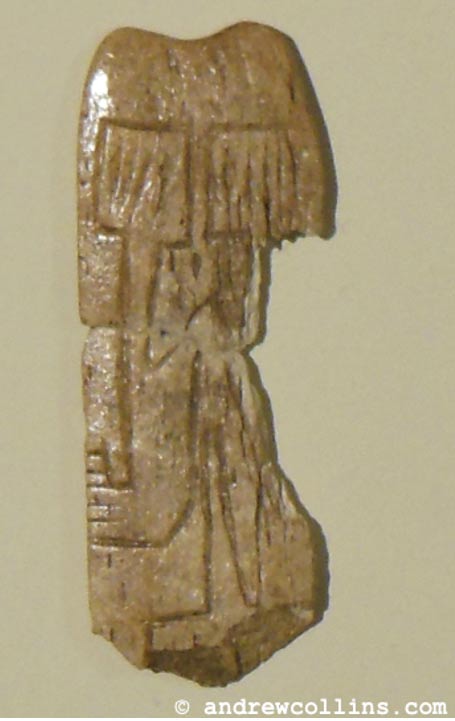Timacua, Florida:
 North Carolina:
North Carolina:

From
http://abob.libs.uga.edu/bobk/ccc/ce090400.html,
year 2000, since surperceded.
ASTRONOMERS AND HENGES
Another image commonly found at Southern Ceremonial sites is that of
dancers dressed in snake costumes. I have little doubt that the people
shown in these images were their "astronomers". It is also well
established that the Southern Ceremonial Cult Priest-Kings harnessed
lightening in their rites: the post holes from trees used as lightening
rods have been located on the tops of their temple mounds, and as I
mentioned earlier there was no differentiation between lightening and
bolides or impacts.
As [Peter] Martyr reports that "Their year is divided into 12 moons.", there
can be little doubt that their astronomy was based on lunar cycles.
Martyr also provides us with a description of what appears to be a
festival at a henge, which is probably the thanksgiving harvest
festival alluded to earlier, and thus took place in the fall:
"Another feast is celebrated every year, when a roughly carved wooden
statue is carried into the country and fixed upon a high pole planted
in the ground. This first pole is surrounded by similar ones, upon
which [the] people hang gifts for the gods, each one according to his
means.
"At NIGHTFALL the principle citizens", [Who is meant here - the lesser
Suns, who were the king's family, or the Nobles, or the Honored Men? It
can't be the Bards.- epg], "divide these offerings among themselves,
just as the priests do the cakes and other offerings given them [the
gods] by the women."
"Whoever offers the divinity the most valuable presents is the most
honored. Witnesses [the Bards-epg] are present when the gifts are
offered, who announce after the ceremony what every one has given, just
as notaries might do in Europe. Each one is thus stimulated by a
spirit of rivalry to outdo his neighbor.
"From sunrise until evening", [Here begins the second day of the feast.
- epg], "the people dance around this statue, clapping their hands. And
when NIGHTFALL has barely set in, the image and the pole on which it was
fixed are carried away and thrown into the sea, if the country is on the
coast, or into the river, if it is along a river's bank." [It must be
remembered in this context that the horned snake asteroids and comets
had a water "aspect", and that space was seen as a cold dark lake.- epg]
"Nothing more is seen of it, and each year a new statue is made."
Ohio
https://news.nationalgeographic.com/new ... t-science/

 Cahokia:
Cahokia:

The Cahokia wood henges are generally assumed to have been inspired by medicine wheels (Siouxian),
but this may not be so.
The colonial traveller's tale is somewhere in my notes in Illinois. Given that the site should be located, I will try to retrieve it.







